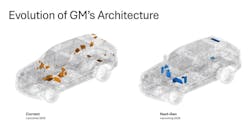GM Advances on Tap: Eyes-Off Driving, Conversational AI, Centralized Computing
What you'll learn:
- In 2028, GM will debut a new centralized computing platform and next-generation electrical architecture across electric and gas-powered vehicles, starting with the Cadillac Escalade IQ.
- The next-gen Super Cruise ADAS feature will be the first true hands-free driver-assistance technology for compatible roads.
- Beginning next year, GM vehicles will feature conversational AI with Google Gemini.
For 2028, GM will offer eyes-off driving in its Cadillac Escalade IQ, an electric SUV, during highway driving. At the GM Forward event in New York, GM Chair and CEO Mary Barra and other senior executives unveiled advances that show how this and other components of the company’s automotive technology are evolving.
One of the most significant steps toward that future is autonomy. According to GM, the next generation of its Super Cruise ADAS feature will present the first true hands-free driver assistance technology for compatible roads, allowing drivers to remove their eyes from the road entirely.
Super Cruise uses cameras, sensors, GPS information, and high-definition LiDAR map data to steer and maintain the vehicle’s position in the current lane. However, in the current version, you still need to pay attention and keep your eyes on the road while using the platform.
The new feature will only be executable on mapped highways. GM has already mapped 600,000 miles of hands-free roads in North America. GM reports that its customers have driven 700 million miles with Super Cruise without a single reported crash attributed to the system.
Conversational AI
Beginning next year, GM vehicles will feature conversational AI with Google Gemini, making it possible to talk to your car as naturally as you would to a fellow passenger. Conversational artificial intelligence (AI) will enable a driver to perform tasks not normally allowed while behind the wheel, including sending texts, planning routes, checking vehicle status, or even finding a place to eat, all solely via voice.
In the future, GM said it will introduce its own AI, custom-built for a given vehicle. With the driver’s permission, it will be fine-tuned with personal preferences, all connected by OnStar.
Also starting in 2026, GM plans to make the full GM Energy Home System (bidirectional EV charging plus a stationary home battery) available via leasing, with terms to be announced later. This will begin with GM EV owners and later roll out to other homeowners interested in backup power and solar integration.
Both GM’s EV and home energy systems are supported by a smartphone app experience. It can educate customers and grow over time to include new capabilities such as vehicle-to-grid programs.
Computing Gets Centralized
In 2028, GM will debut a new centralized computing platform and next-generation electrical architecture across electric- and gas-powered vehicles, starting with the Cadillac Escalade IQ. The update will unite every major system, from propulsion and steering to infotainment and safety, on a single, high-speed computing core.
Much like a smartphone’s single microprocessor that orchestrates everything from your camera to your messages, this centralized approach will connect every system — propulsion, steering, braking, infotainment, and safety — through a high-speed Ethernet backbone.
According to GM, it has the potential to drive these changes:
- Delivering 10X more software updates for new features than GM’s previous system. Already, more than 4.5 million GM vehicles can receive over-the-air vehicle system updates, a number growing by about 2 million per year. Last year alone, 1.6 million vehicles received coordinated software updates.
- Providing real-time safety updates in a self-driving system that reacts in milliseconds and evolves with each autonomous update — faster than GM’s current system.
- 1,000X more bandwidth for faster connectivity, richer entertainment, and future AI workloads.
- Up to 35X more AI computing power (TOPS, or trillions of operations per second) for autonomy and a 2X to 4X boost in infotainment performance.
At the heart of the system is a liquid-cooled central computing unit powered by processors such as NVIDIA’s Thor. The core will connect to three aggregators, serving as hubs for the vehicle’s different zones. All intelligence, including sensor-fusion algorithms, control arbitration, and machine-learning inference, will run on the Thor-powered computing platform. It will centralize processing and simplify software updates by consolidating them to a single location in the vehicle.
This design is said to deliver two major advantages:
- Hardware freedom: Vehicle-specific components stay isolated from the software layer, so GM can swap suppliers or upgrade parts like brake actuators, cameras, displays, and other components without rewriting core code.
- Radical simplification: The new architecture simplifies the network topology. Instead of hundreds of point-to-point connections creating complex wiring and software integration challenges, there are “star-network” topologies with aggregators fanning out to their local zones.
GM’s new platform is propulsion agnostic, engineered to support both electric and internal-combustion vehicles.


